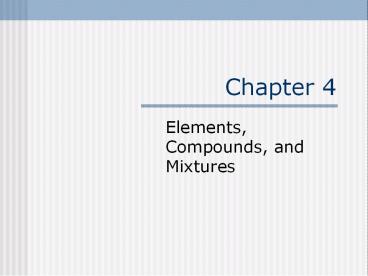Elements, Compounds, and Mixtures - PowerPoint PPT Presentation
Title:
Elements, Compounds, and Mixtures
Description:
Chapter 4 Elements, Compounds, and Mixtures Elements An _____ is a pure substance that cannot be separated into simpler substances by physical or chemical means. – PowerPoint PPT presentation
Number of Views:139
Avg rating:3.0/5.0
Title: Elements, Compounds, and Mixtures
1
Chapter 4
- Elements, Compounds, and Mixtures
2
Elements
- An ___________ is a pure substance that cannot be
separated into simpler substances by physical or
chemical means. - A _______ __________is a substance in which
there is only one type of particle. - These particles are called ________.
- Atoms of different elements are different.
- Atoms of the same element are the same.
3
Properties of Elements
- Each element has its own ________________
properties. - These properties do _____ depend on the amount of
the element present. - Characteristic properties include ___________
point, _________ point, _________, reactivity.
4
(No Transcript)
5
Example
If cobalt and nickel share the same density, 8.9
g/cm3, what other characteristic properties would
distinguish these elements?
6
Classifying Elements
- There are three categories of elements
- ________ elements that are shiny (lustrous),
good conductors, malleable, ductile, on the left
side of the Periodic Table
7
Nonmetals
- _______________ elements that are poor
conductors, brittle, dull, on the right side of
the Periodic Table
8
Metalloids
- ______________ elements that have
characteristics of both metals and nonmetals,
located along the line
9
(No Transcript)
10
Compounds
- A compound is a pure substance composed of ______
or more elements ____________ combined. - The smallest particle of a compound is a
___________. - Molecules of compounds are formed when atoms of
two or more elements chemically join together.
11
(No Transcript)
12
(No Transcript)
13
Figure 1 Page 94
- In this figure, magnesium is burning and
combining with oxygen. - Magnesium oxide is formed.
- ___________ and _________ have undergone a
chemical change. - Magnesium oxide is a compound with ___________
properties than either magnesium or oxygen.
14
Table 1 Familiar Compounds
- According to this table, what elements combine to
form table salt? - ___________ and ____________
- What elements combine to form water?
- ___________ and __________
15
Table 1 Cont
- What compound is formed from a chemical
combination of sodium, hydrogen, carbon, and
oxygen? - __________ _________
16
Ratio of Elements in a Compound
- Elements join to form compounds in a specific
ratio. - The ratio of the mass of hydrogen to the mass of
oxygen in water is 18. - Every sample of water has the same ratio.
- What would happen if a sample of a compound has a
different mass ratio of hydrogen to oxygen? - ______ _________ _______ ______ ___ _______
17
Properties of Compounds
- Each compound has its own _____________
properties. - Compounds can be identified by physical
properties such as density and melting point, as
well as chemical properties such as reactivity. - Properties of the elements are ______ the same as
the properties of the compounds they make.
18
Breaking Down Compounds
- The only way to break down a compound is through
a _________ _________. - Compounds can break down into the elements they
are made of, or they can be broken down into
simpler compounds. - Ex. Glucose C6H12O6 can be broken down into
carbon dioxide (CO2) and water (H2O).
19
(No Transcript)































